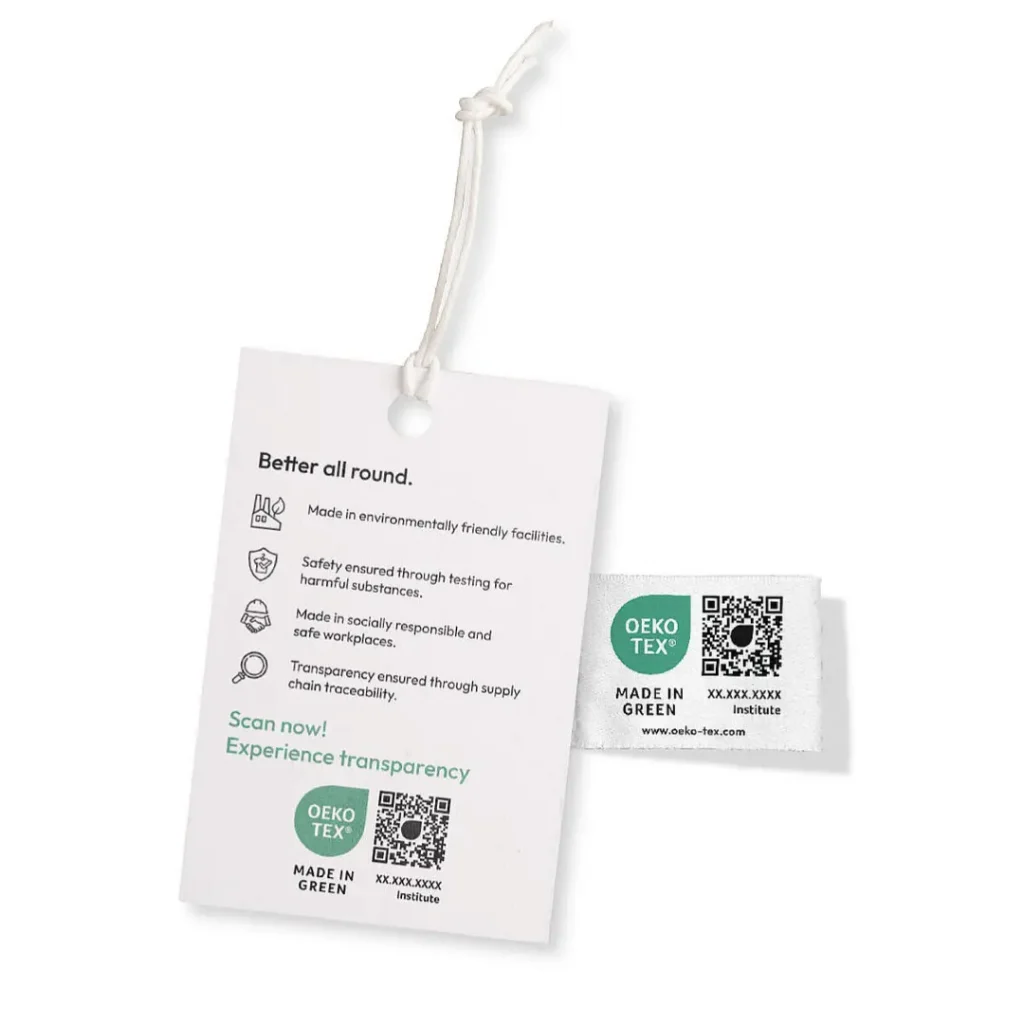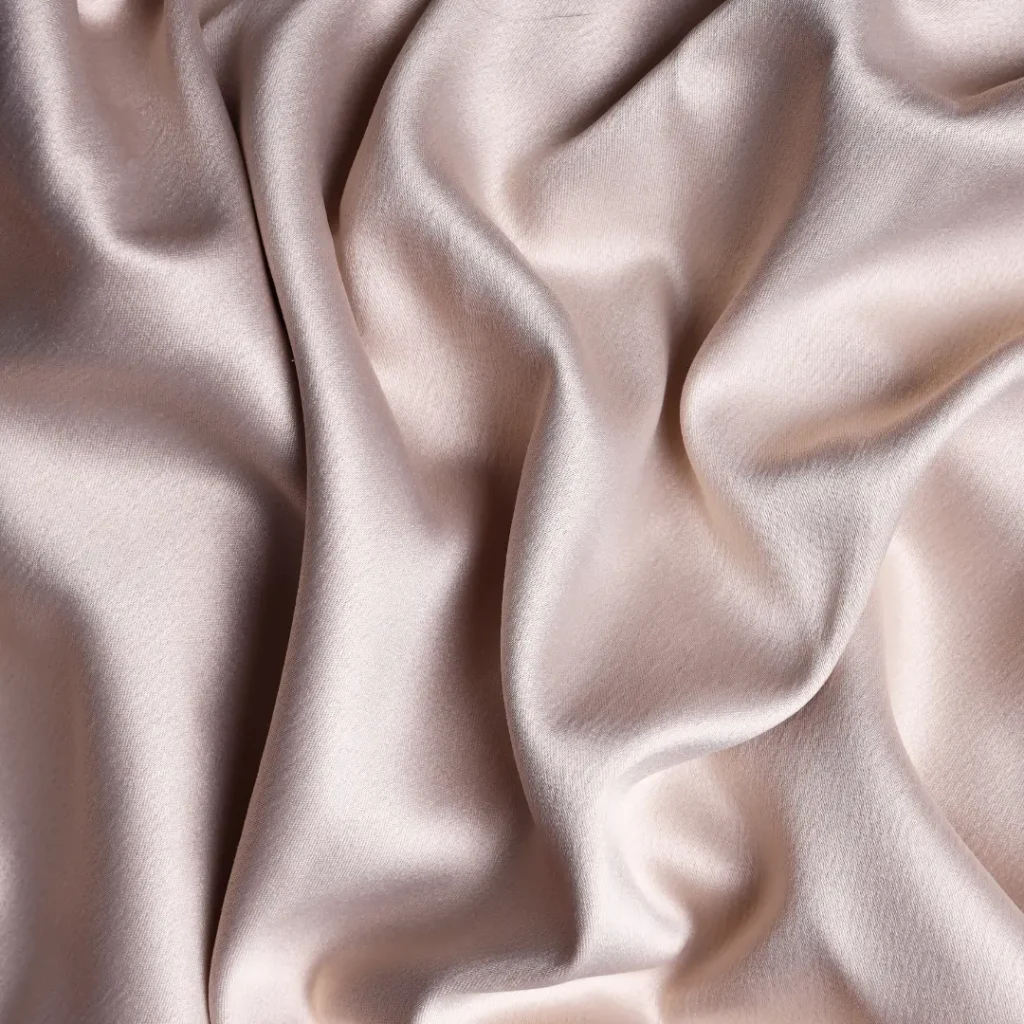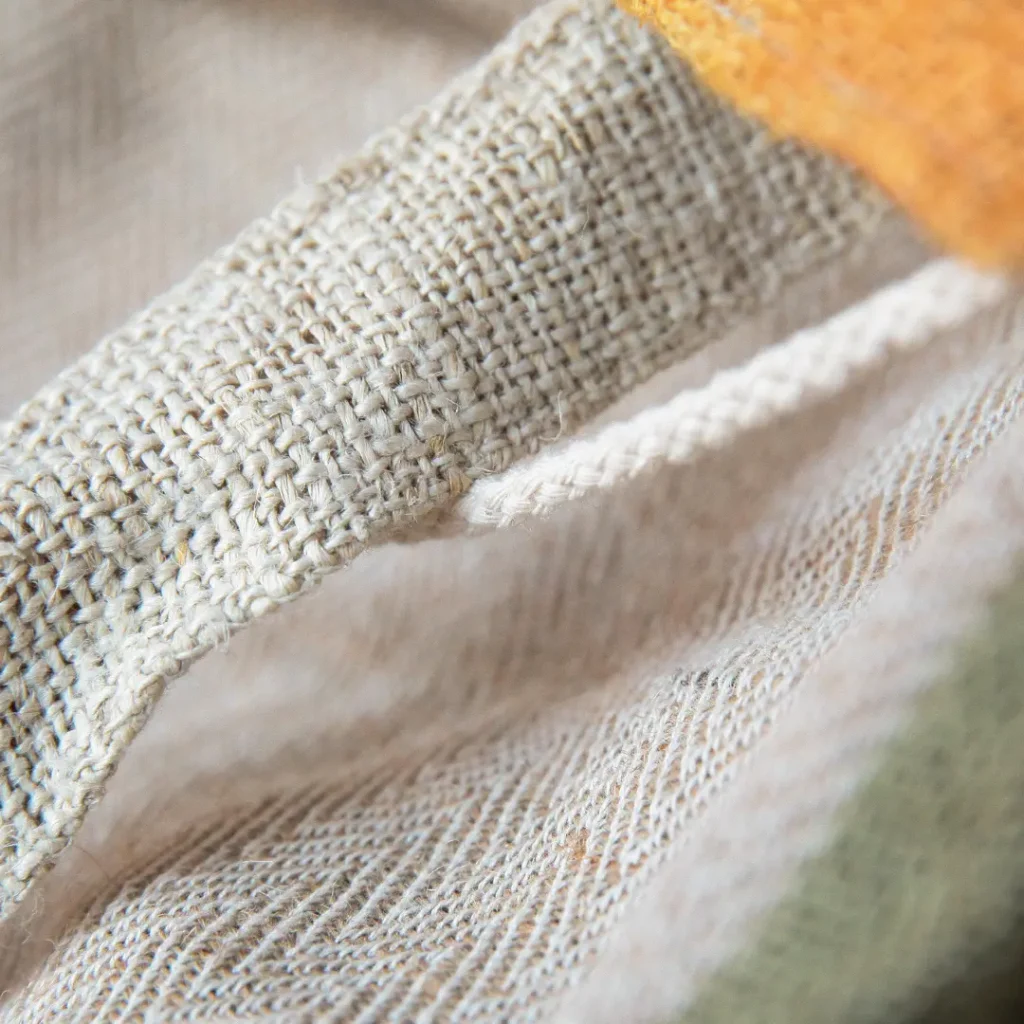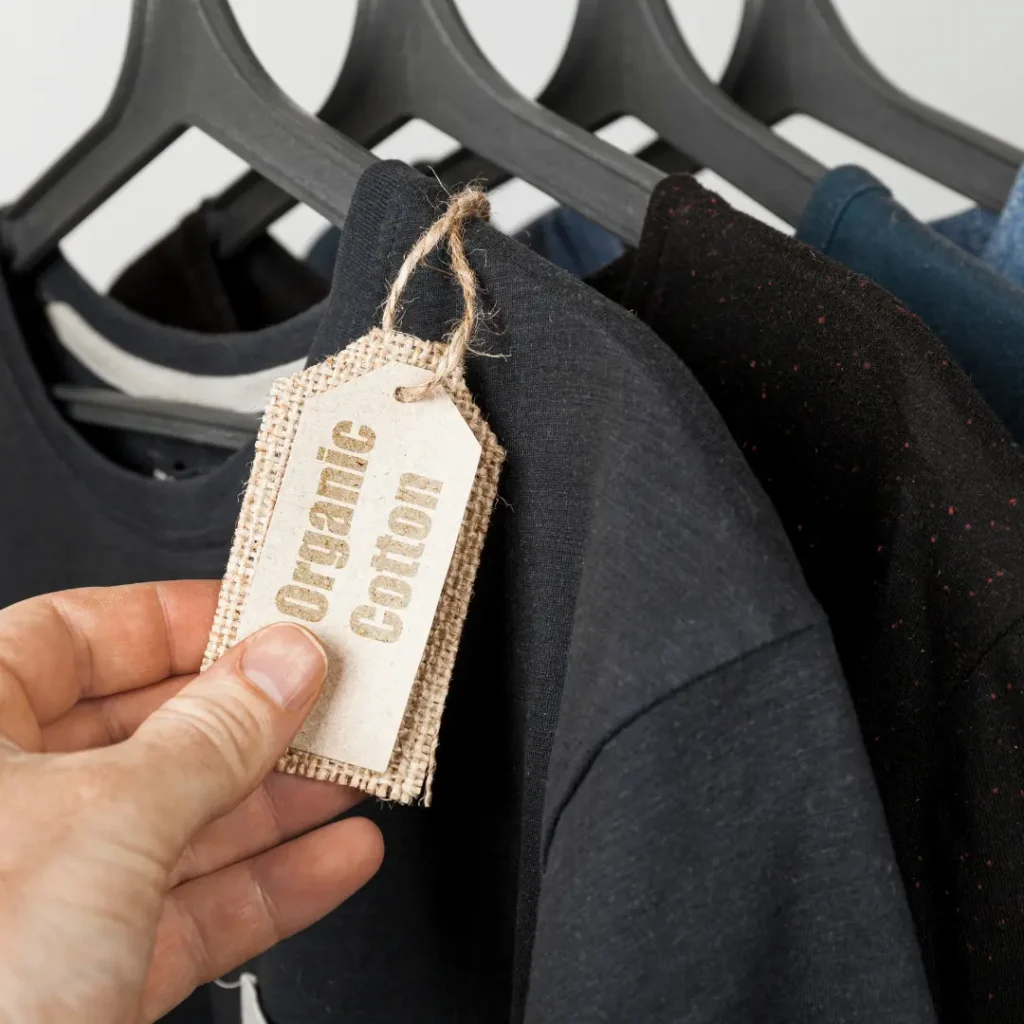Have you ever stopped to think about sustainable living and the fabrics you wear? What are they made of, where did they come from, and how were they produced? Now is a good time to start if you’re interested in learning how to live sustainably.
The textile industry is problematic and wildly wasteful. Fabrics are responsible for pollution and ecological destruction in nearly every part of the product’s lifestyle. Resource extraction, production, shipping, and discarding the product at the end of its life all contribute to environmental damage.
The main ways the textile industry pollutes the Earth are:
- Water pollution. Through the fabric dying process and other textile manufacturing processes. Fabrics are a water-intensive resource to create, and the process leaves that water polluted. Microfiber and microplastic content in our water is also increasing, partially due to the textile industry.
- Air pollution. The apparel and textile industry accounts for roughly 10% of global carbon emissions due to the massive demand for new and cheap textiles. The fast fashion industry is one of the leading causes of the damage caused by textiles.
- Land pollution. Liberal estimates of how much clothing we recycle globally are somewhere around 12%, but the real number could be lower due to corporate greenwashing schemes. The fact is that about 92 million tonnes of textile waste are hauled away and dumped in landfills every year. This is simply not sustainable.
In this blog post, we’ll introduce you to seven sustainable fabrics that are good for both your wardrobe and the environment. We’ll discuss what you should look for when shopping for clothing and other textile-based goods. Read on to learn more!
Things to Look for When Buying New Fabrics
Certification
The label may not be the only thing to consider when shopping for new clothes, linens, or fabrics. Textile certifications can tell a lot about sustainable methods and materials used in production.
For example, organic cotton is grown without the use of harmful pesticides. Fairtrade certification ensures that workers producing these fabrics and garments are treated ethically and paid fair wages.
By choosing textiles with sustainable certifications, we can positively impact both people and the environment. Plus, it’s always good to know that our clothing was ethically produced.
We’ll take a closer look at some of these certifications later on in this post, but keep in mind that you’ll want to keep an eye out for official textile certifications and seals of approval from third-party organizations without a vested interest in the company that produced the product you’re buying.
Material
When shopping for new fabrics, linens, and clothing, one important thing to consider is the materials they are made from. Sustainable materials such as organic cotton, bamboo, hemp, and linen have a lower impact on the environment during production. They also biodegrade more easily at the end of their lifecycle.
On the other hand, synthetic fabrics such as polyester and nylon are made from petrochemicals and can take centuries to break down. Mixed fabrics are difficult to recycle and usually end up getting disposed of.
Next time you’re shopping for new clothes or home goods, make sure to check the tags and read about the materials involved. Choose a sustainable fabric whenever possible. Your choices can make a big difference in promoting sustainable textiles in the fashion industry.
Source
When shopping for new clothing and fabrics, it’s important to consider where they come from.
- Is the fabric sustainable, or was it made with harmful chemicals damaging to the environment and the workers producing it?
- Are the materials sourced ethically, without exploiting workers or putting them in dangerous conditions?
These are important questions to ask as a sustainable consumer. Choosing fabrics and clothing from sustainable sources helps support companies that prioritize environmental and social responsibility. It also reduces our impact on the planet by creating less waste and avoiding harmful production processes.
Dyes
The dyeing process can have a significant environmental impact, with toxic chemicals being released into water sources and air pollution due to the high energy used in production.
However, sustainable dye options do exist and are becoming more widely available. Natural dyes derived from plants and insects offer a range of beautiful hues, minimize environmental harm, and often have less harsh effects on workers’ health.
Here are some commonly used natural dyes:
- Coffee grounds
- Pomegranate
- Avocado pits
- Marigolds
- Indigo
- Chestnut
- Greens like spinach and carrot tops
- Turmeric
Don’t forget to consider the dye used when shopping for sustainable clothing and other textiles and linens. It may not be the first thing that comes to mind, but it can make a big difference in creating a more sustainable fashion industry.
Fabric Certification
Oeko-Tex
The Oeko-Tex certification is a way to ensure that fabrics and materials used in clothing production aren’t harmful to the human body. There are multiple categories of Oeko-Tex certification, and you can read about all the differences between them here. Our recommended Oeko-Tex certification to look for is the Made in Green certification, which we’ll talk about next.


Made in Green
Oeko-Tex Made in Green is one of the best certifications to look for when shopping for textiles. Just like the normal Oeko-Tex certification, every product is made from safe materials.
But in addition, every product is made in an environmentally-friendly facility and free from human rights issues within their supply chain. Take a look at this page for more transparency and specific details (no child labor, fair working conditions and pay, etc.)
We believe that social responsibility is a huge part of sustainability, so go with Oeko-Tex Made in Green over the normal certification when possible!
Fairtrade
Fairtrade certification is another great one to look for because it is also involved with ecological and social responsibility. Here’s all the details on Fairtrade textile certification, but we’ll give you a quick rundown on a few of their policies.
- Requires a living wage paid to all employees.
- Bans certain environmentally harmful materials from being used in the manufacturing process.
- Requires production practices that limit textile and water waste.
- Traceability and transparency are required.
- No child labor or forced labor.
- Limits the use of pesticides and other agricultural practices harmful to the environment, soil, and wildlife.


GOTS certified
The Global Organic Textile Standard (GOTS) is the leading certification for sustainable fabrics made from organic materials. To be “made with organic” certification, a product must contain at least 70% organic fibers. To be “organic” certified, they must be made of 95% organic fibers and meet a long list of other sustainability criteria, including:
- Restrictions on the use of harsh chemicals and pesticides
- Limits on water pollution
- “Assessment” on the living wage gap
- No child labor or forced labor
- Wastewater treatment
- Quality guidelines for finished products
However, some criticisms have surfaced lately about GOTS certification and its reliability. The main takeaways are that GOTS certification does a good job of managing social and environmental issues during manufacturing but may not guarantee an organic product. It may not be able to truly determine if cotton or other materials were farmed sustainably, which is one of the most important elements in distinguishing whether or not a product is sustainable or organic.
Textile Exchange
Textile Exchange is a global non-profit organization that strives to promote sustainable textile production through research and industry partnerships. Together with the International Working Group (IWG), Textile Exchange creates and modifies its standards for certification.
Their certification process ensures that brands meet rigorous sustainable standards, such as minimizing water and energy usage and reducing chemical inputs. This benefits the environment and often leads to cost savings for companies and improved working conditions for workers.
Unlike some of the certifications above, Textile Exchange verifies that the material was farmed organically. They send out auditors to farms and facilities where products are grown and made before approving the certification.
Textile Exchange is a good certification to be on the lookout for, verifying many brand’s claims of recycled content. This area run rampant with greenwashing, so it’s good to have someone looking out for us on this front!

Self-Imposed Certifications
Be aware that some companies attempting to greenwash their marketing will create their own certifications. This way, they can give themselves an official-looking seal of approval on their packaging without the need to be audited by a third party.
If you’re shopping for textiles and you come across a certification you’re unfamiliar with, quickly Google it to check who is responsible for that certification. If it isn’t a third party, it probably means very little regarding sustainability.
Sustainable Fabrics and Materials
Now that we’ve covered a little bit about the textile industry and what to look for in terms of certifications, let’s get into what fabrics and materials are ideal.
These sustainable fabrics are listed in no particular order, but they’re all great options compared to synthetic, petroleum-based fibers like polyester.
We’ve ranked each option as ok, great, or excellent in terms of sustainability and provided some context on how costly each material is in general.
1.) Eucalyptus silk / Vegan silk
First among these sustainable fabrics is eucalyptus silk, also known as vegan silk. Made from the fibers of the eucalyptus tree, it offers a more sustainable alternative to traditional silk.
The production process has a smaller carbon footprint than other fabrics, requiring less water and fewer chemicals. The fabric itself is incredibly soft and durable. You’ll commonly find bedding and other linens made from Eucalyptus silk.
We got our lovely eucalyptus silk bedding from Ethical Bedding, would highly recommend.
Biodegradable
Yes
Cost
$$
Sustainability Score
OK

2.) Tencel and Lyocell
Have you ever heard of lyocell or Tencel fabric? They may not be as well-known as other sustainable fabrics like organic cotton or bamboo, but they do have a lot to offer in terms of sustainability.
Lyocell and Tencel are quite similar to eucalyptus silk because they’re also made from wood pulp fibers. However, they aren’t exclusively made from eucalyptus (though a lot of it is), so we’ve put them in a different category.
So what exactly is lyocell, and how does it differ from Tencel? Lyocell is a sustainable fabric made from wood pulp that has been dissolved using a non-toxic, closed-loop process. Lyocell and Tencel fibers are more breathable and elastic than other fabrics. They’re also wrinkle-resistant, making them a great choice for activewear or sportswear.
Tencel, on the other hand, is simply the brand name for lyocell. Tencel is a sustainable fiber because it’s harvested from certified wood sources. It’s compostable and biodegradable, too! Both lyocell and Tencel fabrics are soft, sustainable alternatives to conventional fabrics like polyester.
Biodegradable
Yes
Cost
$$
Sustainability Score
OK

3.) Bamboo cotton
Have you heard of bamboo cotton before? Probably. It’s quickly becoming a popular sustainable fabric option for clothing and textiles, and for good reason. Why is it better for the environment than traditional options like conventional cotton or synthetic fabrics?
Let’s break it down. Bamboo cotton (also known as bamboo viscose) is made from the pulp of harsh chemical-free bamboo plants, which can grow rapidly without the need for pesticides or fertilizers. Compare that to conventional cotton, which requires large amounts of water and harmful chemicals to produce.
The production process for bamboo cotton also produces far fewer carbon emissions and wastewater than traditional fabrics. Plus, it’s super soft and comfortable!
Biodegradable
Yes
Cost
$
Sustainability Score
Great

4.) Hemp
Hemp is one of the fastest-growing plants and requires little to no pesticides or fertilizers to thrive. Hemp is also incredibly durable and long-lasting, which is refreshing when faced with today’s poly-mix clothing that lasts for a couple of wears and washes. In fact, hemp fibers have been found in ancient clothing that has survived for thousands of years.
Hemp may be one of the most sustainable fabrics in the world, if not the most sustainable. Clothing made from hemp uses significantly less water during production than cotton. Hemp has a quicker growth cycle than most other natural fabrics, including cotton. Hemp garments are biodegradable, so you can just shred them up and compost them when they’ve reached the end of their life cycle.
Importantly, hemp is a zero-waste and carbon-positive crop. Yep, you read that right. Hemp gives more than it takes. Every part of the plant is either edible or useful to humans in some way. And hemp captures a lot of carbon – up to 1.63 tonnes of CO2 per tonne of hemp harvested.
The problem with hemp lies in legislation restricting its growth and use around the world. Many countries don’t allow hemp to be grown on a commercial scale, which is a shame since it’s such a sustainable fabric.
There have been a few advances in this area – in America, 2018’s Farm Bill removed hemp from the legal definition of marijuana, meaning that other parts of the plant can legally be farmed, which opened a door to hemp cultivation in the United States.
Several other countries have followed suit or passed laws before 2018, but there’s still a lot of advocating we need to do in order for hemp to be recognized globally for its potential.
Biodegradable
Yes
Cost
$$
Sustainability Score
Excellent

5.) Organic cotton
Organic cotton offers a sustainable alternative for textile and clothing production. Unlike conventional cotton production, it is grown without the use of harmful pesticides or synthetic fertilizers. This not only protects the health of farmers but also benefits the environment by preserving biodiversity and reducing pollution.
Even organically grown cotton isn’t the most eco-friendly option, but it’s leagues better than conventional cotton or something like polyester. Cotton is one of the most popular and widely accepted fabrics for clothing, and other linens, so organic cotton is a great alternative for people who are used to cotton clothing and textiles.
Organic cotton uses less water during production and is typically made by companies who are attempting to lower their environmental impact. Sustainable practices also extend to manufacturing since organic cotton can be dyed with eco-friendly and low-impact dyes.
One of the biggest pros of organic cotton is that it’s one of the easiest materials to find with Fairtrade certification. You’ll likely find sustainable clothing brands working with Fairtrade organic cotton, and that’s your best bet at buying truly organic cotton that was manufactured sustainably.
Biodegradable
Yes
Cost
$
Sustainability Score
Ok

6.) Organic linen
Organic linen is made from flax plants grown without pesticides or synthetic fertilizers, resulting in a lower impact on the environment. It’s biodegradable and uses roughly 3% of the water that organic cotton does, which means it’s near the top of the list in terms of sustainability. Organic linen is known for its durability and softness, making it a sustainable yet luxurious choice for clothing and textiles.
Linen isn’t an ideal choice if you live in a cold climate, but it’s perfect for bedding, other linens, and summertime clothing. It can be a bit pricey compared to cotton, but it’s a little more eco-friendly at the end of the day.
Biodegradable
Yes
Cost
$$
Sustainability Score
Excellent

6.) QMONOS
QMONOS is made by a Japanese company, Spiber, that creates bioengineered sustainable fabrics. A synthetic spider silk that is many times strong as steel is their most-discussed product. The synthetic spider silk fabric has a broad range of applications, not only in the textile industry, but also for medical and scientific uses. This protein-based fabric is obviously unique but quite expensive and uncommonly available.
What’s so compelling about a fabric like QMONOS is that it’s made from brewed protein polymers and can fully be recycled into new garments when the original ones are worn through.
From their website, “Our technological foundation, with microbial fermentation (brewing) at its core, will pave the way for a variety of biomaterials to be upcycled, ushering in a new era where we can free ourselves from the concept of waste and truly become a recycling-oriented society.“
They are already focused on providing transparency and traceability within their supply chain and intend to apply regenerative farming practices for their feedstock during the brewing process. All of which you can find information for on their website. While QMONOS might not be widely available right now, it’s a name to remember and look out for in the future.
Biodegradable
Yes
Cost
$$$
Sustainability Score
Great

FAQs about fabrics
Is wool sustainable?
When it comes to sustainable fabrics, wool often gets discussed. Wool has something to offer in terms of sustainability. For starters, sheep naturally produce wool as a way to regulate their body temperature. This should mean it is a natural by-product of sheep farming.
Wool is also durable and can last for years without breaking down or needing to be replaced. When it comes time to dispose of wool fabric, it’s biodegradable and can easily break down without causing harm.
The flip side of this comes the reality of farming methods. Several documentaries such as Dominion released in 2018 show some of the horrific ways animals are treated in modern agriculture. Even in countries with supposedly strict animal cruelty laws.
For this reason, we cannot recommend the use of wool or any animal products.
Is polyester sustainable?
No. Polyester is a synthetic fabric made from petroleum, which is a non-renewable resource. It’s not biodegradable, so it can’t be broken down by the Earth once it’s disposed of. Polyester also pollutes the water during production and emits harmful chemicals when it’s washed.
Is recycled polyester sustainable?
Only somewhat if it’s 100% recycled polyester without any virgin material. In general, we don’t recommend purchasing clothing made with polyester. Even if you purchase it secondhand, washing polyester clothing sheds microplastics and microfibers, which pollute our water.
What are the most sustainable fabrics?
Anything that isn’t petroleum-based is a more sustainable option, especially linen and hemp fabrics. There are many factors to consider when it comes to determining the sustainability of a specific fabric, including where it was farmed, where it was manufactured, whether it has a third-party certification, who made it, how it was dyed, and whether it’s recyclable or compostable.



